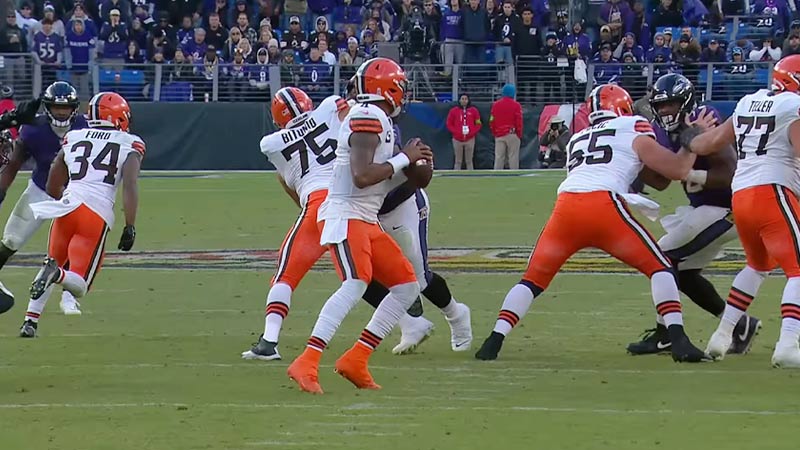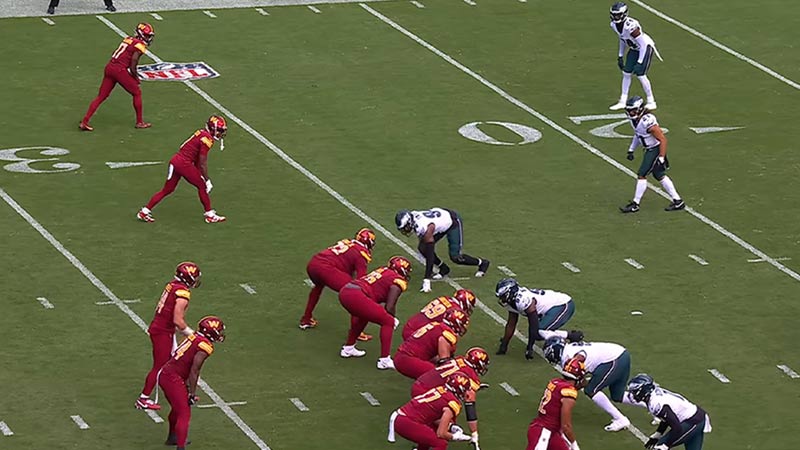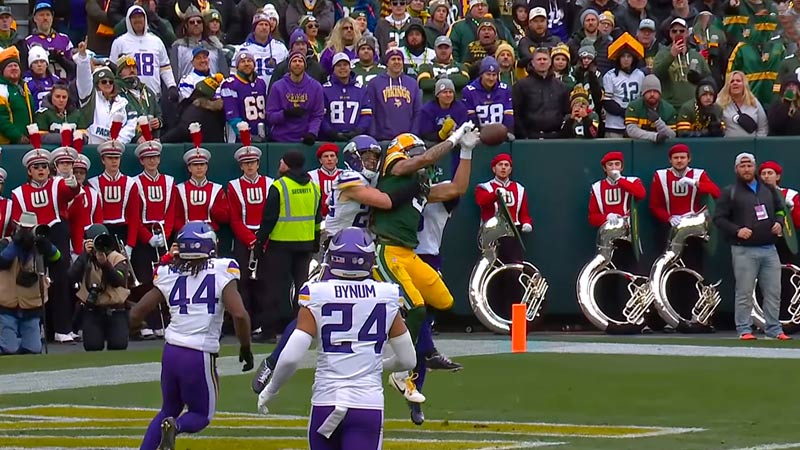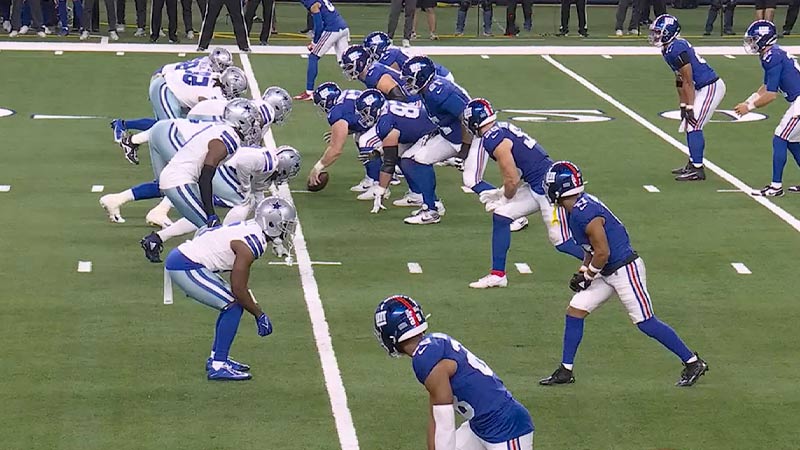The I-Formation in American football is a timeless and versatile strategy, offering a dynamic blend of power running and effective passing.
Forming the backbone of numerous successful offenses, this alignment positions the quarterback, fullback, and tailback in a distinctive “I” shape, enabling teams to execute a balanced and unpredictable game plan.
From classic dive plays to intricate play-action passes, the I-Formation has become a staple in the sport, showcasing its adaptability to various offensive strategies.
In this guide, we delve into the intricacies of the I-Formation, exploring its advantages, common plays, adaptability, and strategies for countering opposing defenses.
What Is I Formation in Football?
The I-formation is a formation in American football that is commonly used on offense.
It is named for the shape of the alignment of players on the field, where the quarterback lines up directly behind the center, and the fullback and tailback (or halfback) align behind the quarterback in a line, creating the “I” shape.
Here’s a breakdown of the key positions in the I-formation:
Quarterback (QB)
He lines up directly behind the center, usually about 4 to 5 yards from the line of scrimmage.
Fullback (FB)
He lines up in a position directly behind the quarterback, typically a few yards away. The fullback is often a larger, more powerful runner and may be used as a blocker in various plays.
Tailback or Halfback (TB or HB)
He lines up behind the fullback in the same vertical line but farther back. The tailback is often a faster, more agile runner and is a key ball carrier in many running plays.
The I-formation provides a balanced set for both running and passing plays.
It allows for a power-running game with the fullback leading the way for the tailback, and it also provides the quarterback with a clear view of the field for passing plays.
The formation can be adapted for various offensive strategies and is versatile in terms of the types of plays that can be run from it.
Coaches may use variations of the I-formation to suit their team’s strengths and the specific needs of a game.
The I-formation has been a staple in football for many years and remains a popular choice for teams at various levels of play.
The Power of Balance in American Football I Formation?

The power of balance in the I-formation in American football lies in its ability to keep the defense guessing and to execute both running and passing plays effectively.
Here are some key aspects of the power of balance in the I-formation:
Run-Pass Options (RPOs)
The I-formation allows for a balanced mix of running and passing plays. This balance keeps the defense uncertain about the offense’s intentions.
Quarterbacks in the I-formation can execute run-pass options (RPOs), where they can either hand the ball off for a run play or pass the ball based on the defensive alignment.
Power Running Game
The fullback in the I-formation often serves as a lead blocker for the tailback, creating a powerful running game. The balanced alignment allows for various running plays, including dives, off-tackle runs, and sweeps.
Establishing a strong running game puts pressure on the defense and opens up opportunities for play-action passes.
Play-Action Passing
The I-formation is particularly effective for play-action passing. Since the running game is a significant threat from this formation, play-action fakes to the running backs can draw defenders toward the line of scrimmage.
This, in turn, creates opportunities for the quarterback to pass the ball downfield to receivers who may have gained separation from the defenders.
Versatility and Adaptability
The I-formation is versatile and can be adapted to different offensive strategies. Teams can emphasize either the run or the pass based on their strengths and the weaknesses of the opposing defense.
This adaptability allows offenses to exploit mismatches and adjust their game plan during a game.
Field Vision for Quarterback
The quarterback in the I-formation has a clear view of the entire field, making it easier to read the defense and make quick decisions.
This visibility is advantageous for both running and passing plays, as the quarterback can assess the defense’s alignment and adjust the play accordingly.
The power of balance in the I-formation stems from its ability to keep the defense off-balance, execute a potent running game, and set up effective play-action passing.
This balance makes it challenging for opposing defenses to predict the offense’s next move, ultimately providing the offense with a strategic advantage on the field.
Passing Plays from the I-Formation

While the I-formation is often associated with a power-running game, it can also be utilized effectively for passing plays.
The play-action passing game is a significant component of the I-formation, but teams can incorporate various passing plays to keep the defense guessing.
Here are some common passing plays from the I-formation:
Play-Action Pass
One of the primary passing plays from the I-formation involves using play-action. The quarterback fakes a handoff to the running back, attempting to draw in the linebackers and safeties, and then looks to pass the ball downfield.
Receivers run routes that take advantage of the defense’s reaction to the play-action, creating potential openings in the secondary.
Bootleg
In a bootleg play, the quarterback fakes a handoff to a running back and then rolls out to one side of the field.
This play can create opportunities for the quarterback to pass to receivers who have moved with him or to run if the defense over-commits to stop the pass.
Quick Play-Action Slant
A quick play-action slant involves a short fake to the running back, and then the quarterback delivers a quick pass to a receiver running a slant route across the middle of the field.
This play aims to exploit openings in the short to intermediate passing areas.
Deep Post Route
The I-formation can be used to set up deep passing plays, such as the deep post route. Receivers run downfield and make a sharp cut toward the center of the field.
This can catch the defense off-guard, especially if they expect a run.
Screen Pass
Screens can be effective from the I-formation, particularly with a mobile fullback or running back.
The quarterback takes a short drop and then tosses the ball to a running back or receiver who has positioned themselves behind the offensive line, using blockers to gain yards after the catch.
Flood Route Concept
The flood route concept involves sending multiple receivers to one side of the field at different depths. This can create mismatches and confusion for the defense, and the quarterback reads the coverage to find the open receiver.
Corner Route
In a corner route, a receiver runs toward the corner of the end zone. This can be effective in goal-line situations or when trying to stretch the field vertically.
Curl Route
Receivers curl routes, sprinting downfield and then coming back toward the quarterback, finding open spaces in the intermediate area of the field.
These are just a few examples, and coaches can design various passing plays based on their personnel’s strengths and the opposing defense’s weaknesses.
The key is to maintain a level of unpredictability and keep the defense honest by mixing in passing plays with the power running game typically associated with the I-formation.
Running Plays from the I-Formation in Football

The I-Formation is well-known for its effectiveness in running the football and provides a powerful and balanced attack on the ground. Here are some common running plays from the I-Formation:
Dive/Inside Run
The fullback takes a quick handoff and runs straight ahead through the A or B gap (the gap between the offensive linemen). This play aims to gain quick and tough yards up the middle.
Off-Tackle Run
The tailback takes a handoff and runs to the outside, aiming for the area just outside the offensive tackle. The fullback or pulling offensive lineman often leads the way, blocking for the runner.
Power Sweep
In the power sweep, the fullback or a pulling guard leads the tailback around the edge. The offensive linemen block down, and the runner looks for openings along the sideline.
Counter Run
The counter is designed to mislead the defense. The fullback initially moves in one direction, drawing the defense that way, and then the tailback takes the handoff moving in the opposite direction with pulling linemen blocking for him.
Trap Run
In a trap play, an offensive lineman allows a defensive lineman to penetrate the line before being trapped (blocked) by another offensive lineman. The ball carrier then runs through the gap created by the trap block.
Lead Draw
The lead draw involves a delayed handoff to the tailback, allowing the offensive linemen to engage their blocks before the runner takes the ball and looks for an opening in the defense.
Stretch Run
The stretch run involves the tailback taking the handoff and running toward the sideline, following the offensive line blocks as they stretch the defense horizontally.
Isolation Run (Iso)
In an isolation play, the fullback leads through the hole, blocking the first linebacker or defender in the middle. The tailback then follows the fullback through the opening.
Pitch Sweep
The quarterback pitches the ball to the tailback, who then runs toward the sideline with blockers in front, attempting to turn the corner and gain yards along the edge.
Draw Play
The draw play is a delayed handoff where the quarterback drops back as if to pass before handing the ball off to the tailback. This momentarily freezes the defensive linemen, creating space for the runner.
These running plays from the I-Formation are designed to exploit different areas of the defense and take advantage of the physicality and blocking abilities of the fullback and offensive line.
Coaches often mix and match these plays based on the strengths of their personnel, the defensive alignment, and game situations.
The I-Formation’s versatility in both running and passing makes it a well-rounded offensive strategy.
Countering Defenses in American Football I Formation
Effectively countering defenses in American football, regardless of the formation used, involves strategic planning, adaptability, and exploiting the weaknesses of the opposing defense.
Here are some general strategies for countering defenses when using the I-Formation:
Mixing Run and Pass Plays
Keep the defense off-balance by mixing both running and passing plays. The I-Formation allows for a balanced attack, and unpredictability can be a powerful weapon against the defense.
Utilize play-action passes to take advantage of the commitment to stopping the run.
Identifying Defensive Fronts
Have the quarterback and offensive line identify the defensive front and make pre-snap reads. This helps determine potential weak points in the defense and adjust the play accordingly.
Exploiting Mismatches
Identify individual matchups that favor your offense.
This could involve targeting a receiver against a mismatched cornerback, exploiting a slower linebacker with a speedy running back, or capitalizing on a size advantage in the trenches.
Adjusting Blocking Schemes
Be prepared to adjust blocking schemes based on the defensive alignment. If the defense is stacking the box to stop the run, consider pulling guards, using traps, or running outside to exploit the edges.
If the defense is playing coverage, emphasize the running game.
Play-Action Success
If the play-action passing game works well, it can force defenders to bite on fakes, creating openings in the secondary. Establishing a strong running game helps sell play-action fakes more effectively.
Utilizing Motion and Shifts
Incorporate pre-snap motion and shifts to confuse the defense. This can force defenders to adjust their alignments and can reveal information about the defensive coverage.
Screen Plays
Implement screenplays to counter aggressive pass rushes. Screens, such as the halfback screen or wide receiver screen, can slow down pursuing defenders and turn their aggression into a disadvantage.
Audibling
Allow the quarterback to audible at the line of scrimmage based on the defensive look. If the defense is vulnerable, the quarterback can change the play to exploit it.
Testing the Secondary
If the opposing secondary is a weak point, take shots down the field with deep passes. Stretching the field vertically can force the defense to defend every area, opening up opportunities for both the run and short passing game.
Managing Clock and Game Situation
Consider the game situation, including the score, time remaining, and field position. Adjust the offensive strategy based on whether you’re ahead, behind, or in a close game.
Effective communication and understanding between coaches, the quarterback, and the rest of the offense are crucial for successful adaptations during a game.
The I-Formation’s versatility allows for various adjustments to exploit defensive weaknesses and maintain offensive balance.
FAQs
What is the I-Formation in American football?
The I-Formation is an offensive alignment where the quarterback lines up directly behind the center, and the fullback and tailback align behind the quarterback in a line, forming an “I” shape.
It’s commonly used for a balanced attack, incorporating both running and passing plays.
What advantages does the I-Formation offer?
The I-Formation provides a balanced offensive approach, allowing for a potent running game with power and misdirection plays.
It also sets up effective play-action passing, as the quarterback has a clear view of the field, creating unpredictability and keeping the defense off-balance.
How can the I-Formation be adapted for different strategies?
The I-Formation is versatile and can be adapted for various offensive strategies. Teams can emphasize either the run or pass based on their strengths and the weaknesses of the opposing defense.
Different running and passing plays can be integrated to suit the team’s game plan.
What are common running plays from the I-Formation?
Common running plays from the I-Formation include the dive/inside run, off-tackle run, power sweep, counter run, trap run, lead draw, stretch run, isolation run (iso), pitch sweep, and draw play.
These plays utilize the strengths of the fullback and tailback in different ways.
How can teams counter defenses when using the I-Formation?
Teams can counter defenses in the I-Formation by mixing run and pass plays, identifying defensive fronts, exploiting mismatches, adjusting blocking schemes, etc.
Besides, it involves using motion and shifts, incorporating screenplays, allowing the quarterback to audible, testing the secondary with deep passes, and considering the game situation.
Wrapping Up
In the realm of American football, the I-Formation stands as a testament to strategic brilliance and adaptability.
Its enduring presence on the field, balancing the raw power of a running game with the finesse of play-action passing, underscores its significance in shaping successful offenses.
The I-Formation remains reliable and dynamic as teams navigate the game’s complexities.
Whether executing a well-timed counter or orchestrating a precision pass, this formation provides the tools for offensive mastery.
Understanding its nuances, leveraging its versatility, and countering defenses effectively, teams can continue to unlock the potential for success that the I-Formation has embodied throughout the sport’s history.
It’s not just a formation; it’s a playbook for triumph on the gridiron.







